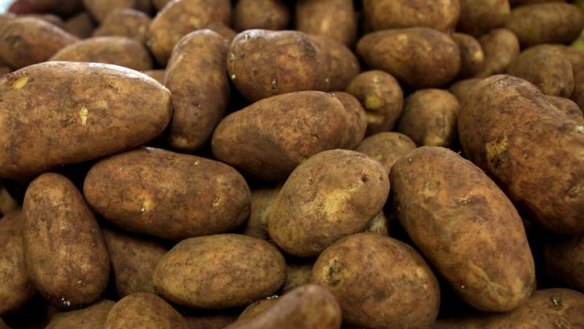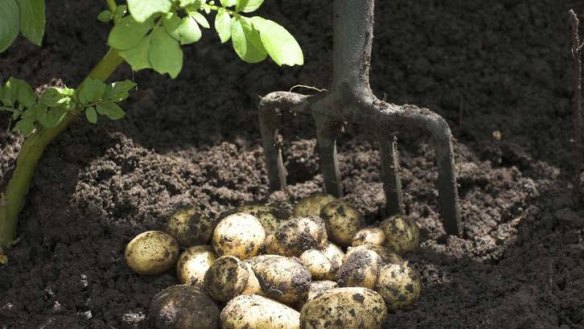For spuds, chit your chats

It's difficult to imagine life without potatoes now, but they only spread worldwide after the Spaniards brought them to Europe from Peru in the 16th century, and for the next 200 years in countries such as Germany, they were grown only as animal feed.
Potatoes are the world's fourth most popular food crop. In Australia, yields have more than doubled over 60 years. Australia's yield of 35 tonnes a hectare is double the world average and on par with Ireland and Denmark. New Zealand is a standout, with some commercial farmers achieving up to 80 tonnes a hectare.
An achievable target is to harvest 10 times the volume of the potatoes that you are planting. A three-square-metre garden with four rows can produce 80 to 100 kilograms of potatoes. You just need to allocate the space for 14 to 16 weeks and regularly tend to the crop.

Potatoes grow best in well-drained soil that is not too heavy and has a high ratio of organic matter. Crop rotation is vital to prevent the build up of soil-borne diseases - so avoid planting in any section of the garden that has grown any of the solanum family (tomatoes, capsicums, eggplant and potatoes) in the past three years.
Buy only certified seed potatoes; do not used potatoes from the supermarket.
Be sure to chit your potatoes before planting - leaving the seed potatoes for a couple of weeks in a semi-dark place to begin growing shoots. Then make sure that one of the eyes of the potato is heading skywards when planting, so it can produce a vertical stem.
Plant seed potatoes 60 centimetres apart along the rows and 20 centimetre deep. Allow 75 centimetres between rows. If you have very large tubers that need to be cut in half, rub the cut surface into some potash from a fireplace to seal it.
Plant potatoes in a trench and hill up as the plant begins to grow. When the green tips emerge through the soil, hill up further. Always protect the tubers from exposure to sunlight - if they are not surrounded by plenty of soil, the ends of the growing tubers will push through to the surface and begin to green up.
At least 80 per cent of the potato crop will be produced above and not below the original seed potato. Each branching of the potato plant stem is capable of producing new potatoes, so a regular hilling up or addition of a deep straw mulch will help a higher yield.
Potato plants grow a leafy canopy, then produce mauve and white flowers. At the same time, tubers begin to grow off their root structure.
You can begin to harvest an early crop by bandicooting along the side of each row, digging in and removing a number of small potatoes, often referred to as chats. A well hilled and mulched garden bed makes for ease of access at the side of each plant.
Chat potatoes are fantastic to cook whole and serve in their jackets, but new potatoes dug before maturity do not keep well so only dig up what you are going to use immediately and leave the rest to fatten up.
If you have limited space, you can plant just a few tubers into a vertical garden. You can either use several old car tyres stacked on one another or build a circle pen with chicken wire and four-star pickets. After planting the tubers into some soil in the base of the plot, regularly top up the bed with compost, straw, rotted manure and soil.
Choose your seed potatoes from three groups. Waxy potatoes are high in sugar and low in starch, hold together well when cooked and are good for boiling and baking. Floury potatoes have a high starch content but are low in moisture and sugar. They fall apart when boiled but fry and roast extremely well. The ''all rounders'' have medium starch levels, so can be mashed, roasted and fried.
Waxy potatoes include desiree, pontiac, bintje, nicola, jacqueline and pink eye. Desiree is an excellent Dutch potato with rosy skin. It can produce a high yield even in a hot dry summer. Nicola remains a favourite of our family. It has a rich yellow, buttery flesh, which produces wonderful mash but is also excellent baked, boiled or in salads. It is the standout for gnocchi.
Floury potatoes include the well known sebago as well as King Edward, bison and coliban. The white flesh is ideal for baking and boiling.
All-rounder potatoes include dutch cream, toolangi delight, kennebec and royal blue. Dutch cream has a yellowish skin and rich yellow, waxy flesh. It is excellent for boiling, gratins, soups, roasting and baking. Toolangi delight is one of the best potatoes for making potato and leek soup; it produces a really smooth, creamy soup.
>> Owen Pidgeon owns the Loriendale Organic Orchard near Hall.
This week
■ Fork over your garden beds and add in compost in preparation for planting spring vegetables.
■ Plant a row of carrots and beetroot, snow peas, celery and celeriac.
■ Plant early-summer cabbage and leek seedlings.
■ Complete planting late-season onion seedlings.
■ Plant tomato, capsicum and zucchini seeds into propagation trays and keep in a warm, sunny place while they germinate.
■ Prune old growth from perennial herbs, including sage, rosemary and thyme.
The best recipes from Australia's leading chefs straight to your inbox.
Sign up